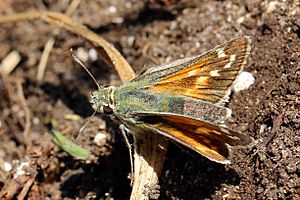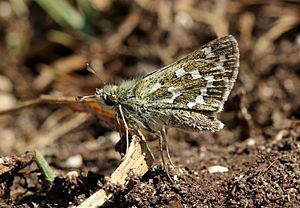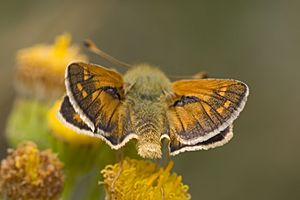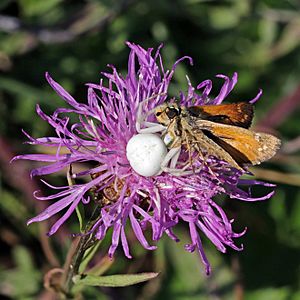Silver-spotted skipper facts for kids
The silver-spotted skipper (Hesperia comma) is a small, fast-flying butterfly. It belongs to the Hesperiidae family, often called "skippers" because of their quick, darting flight. In Europe, it's known as the silver-spotted skipper. In North America, it's called the common branded skipper. Another butterfly, Epargyreus clarus, is also sometimes called the "silver-spotted skipper" in North America.
Quick facts for kids Silver-spotted skipper |
|
|---|---|
 |
|
| Female | |
 |
|
| Female underside, Aston Rowant, Oxfordshire | |
| Scientific classification | |
| Genus: |
Hesperia
|
| Species: |
comma
|
| Subspecies | |
|
See text |
|
| Synonyms | |
|
|
Contents
What Does the Silver-Spotted Skipper Look Like?
This butterfly is sometimes confused with the large skipper (Ochlodes venata). But you can tell them apart! The silver-spotted skipper has many white spots on the underside of its back wings. Also, the tips of its front wings are usually darker than those of the large skipper.
These two butterflies also fly at different times of the year. In Britain, the large skipper usually finishes its flight period by the time the silver-spotted skipper starts flying in August.
Where Do Silver-Spotted Skippers Live?
The silver-spotted skipper likes warm, chalky areas. It lives in many places, from North Africa in the south, all across Europe to the Arctic in the north, and eastwards through Asia to China and Japan. It also has different types (subspecies) in North America. In the UK, it is quite rare. It mostly lives on chalk downlands in southern England.
Life Cycle of the Silver-Spotted Skipper
The female silver-spotted skipper lays single eggs during August and September. She places them on the leaves of a plant called sheep's fescue (Festuca ovina). This is the only plant the caterpillars eat. Sometimes, eggs are laid on nearby plants too.
Female butterflies are very particular about where they lay their eggs. In the UK, most eggs are laid in short grass, about 4 centimeters tall. They are often laid next to patches of bare ground.
From Egg to Butterfly
The silver-spotted skipper spends the winter as an egg. The eggs hatch in March. Like other skippers, the larvae (caterpillars) build small, tent-like homes. They make these from leaf blades and silk. They feed from inside these little tents.
After 14 to 15 weeks, the caterpillars turn into pupae. This happens at the base of their food plant. The pupal stage lasts for 10 to 14 days. Just like most butterflies, the male butterflies usually emerge first.
Helping the Silver-Spotted Skipper in the UK
Good news! Because of special efforts to protect this butterfly in the UK, its numbers are growing. Government groups have helped a lot. This butterfly, which was once threatened, is now doing well in some areas.
Over the last twenty years, the number of silver-spotted skippers has gone up by about 1500%! The number of places where they live has also increased from just 68 sites. Now, 202 new places have been set up for them. These conservation plans have focused on giving the silver-spotted skipper good places to live. This has had very positive results!
See also
 In Spanish: Hesperia comma para niños
In Spanish: Hesperia comma para niños




